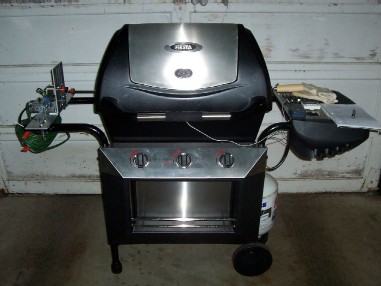
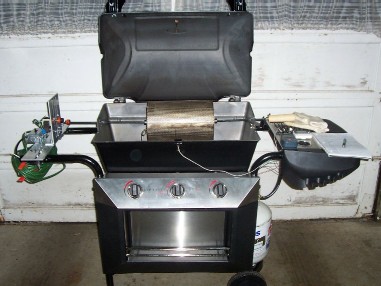
Built, Owned and Operated by: Tim Eggers
November 26, 2005
Last Edited: June 8, 2008
What is the RK Drum?
The RK Drum is an all stainless steel drum that is used to roast green coffee beans using a standard rotisserie gas grill. Mr. Ron Kyle makes the drums and more information can be found at:
http://www.rkdrums.com. My review for the RK Drum can be seen here.
One Year Update:I have been using the Rk Drum for over a year now and I can see no signs what so ever of any wear. I do store the roaster inside my garage, never outside in the elements. The drum still looks and functions great. No problems what so ever. The only part that I suppose could wear is the nut on the spit rod where the rod rests against the bracket. Due to rotation this is a wear point. Even there I see no immediate wear. I have roasted a couple hundred pounds easily and the results are exceptional. The roaster is still in great shape and I still highly recommend it to anyone looking for the best possible home roasting results! I love the ability to roast up to four pounds with no physical work. Such a nice and easy to use set-up, I wouldn't give it up for anything, and it should last me many more years. The best coffee investment I have ever made!
Update 3/9/08: The RK Drum is still working beautifully. This thing is a real tank. My roasting set-up is every bit as good as the day I first set it up. I can see myself using this roaster for a long, long time. Highly recommended! It has paid for itself time and time over by now. I love this roasting method and the RK Drum is built to last.
Is the RK Drum difficult to set-up or use?
The RK Drum is very easy to set up and within minutes you will be roasting coffee. Although the drum will hold up to four pounds, I have found best results at 1 pound of green beans. I assembled the grill, installed the drum and mounted the motor is about an hour (I took my time and enjoyed myself).
It takes only a few basic tools (the drum comes with an hex key and so does the motor, I also used an adjustable wrench and a screwdriver). All the hardware comes with full instructions that are very easy to follow.
I am amazed at how easy it was to set up and get roasting with the RK Drum set up.
What do I need to use the RK Drum?
You do need a gas grill of at least 35,000 BTU or more. The grill should also be rotisserie ready.
Also needed is a rotisserie kit, I like the Char-broil kit widely available with the one-piece spit rod. You will see below that I use the RK Home Roasting motor because the Char-broil motor just doesn't like to do more than one pound and it really doesn't like the heat of coffee roasting. I strongly recommend the RK Home Motor or similar motor. The faster RPM also makes for a much better roast results.
You will also need a thermometer. Although analog post style thermometers will work I like the digital one on this page much more!
You will also need means to cool the beans when the roast is finished. You can see what I use below. As well as gloves that will withstand 500F for 30 seconds or more. I like the Ove-Glove brand.
There is more information on www.rkdrums.com.
How do I roast coffee with the RK Drum?
Roasting coffee is so easy. Here is how I do it, your results may vary:
Please note that roasting coffee produces smoke. Many people really enjoy the light sweet fragrance of the smoke but be warned there is smoke! So roast outdoors and never leave a hot grill especially with coffee in it unattended!
Update 3/20/08: Since becoming serious about home espresso I've discovered that my old approach does not produce very good roasting results for my tastes. I've adopted a different approach and encourage you to try it too:
1) Preheat grill (with drum installed) too about 450F.
2) Load drum with one pound green beans (careful its very hot)! Start timer.
3) Leave the burners on setting to maintain 450F. Very first snaps of first crack which should be start around 10-12 minutes.
4) As first crack starts adjust grill lower (to a reading of about 400F) for the duration of the roast. Vienna (the very first snaps of second crack) should start 6-8 minutes (NO LATER) than the end of first crack. With a rapid second crack underway no more than 10:00 after the end of first crack (this is the darkest I roast for espresso).
Please note that these settings work for me on my specific grill. You may have to adjust for best results. I've also found the above to produce good coffee for both espresso and non-espresso uses.
What do the different roast levels taste like?
The only way to understand a coffee is to roast it. Depending on how far you roast a coffee it can have a strikingly different flavor and body in the cup once brewed.
Typically speaking the lighter roasts (or those stopped just after the complete finish of first crack) will have more origin character (the beans actual flavors rather than roast induced flavor) and acidity with a muted body or mouth feel. However if you stop the roast too soon before the roast has fully developed (or before the end of first crack) the coffee will have a sour and/or grassy flavor.
Medium roasts (stopped a short while after the complete finish of first crack) can create a balance between the sometimes raw, aggressive origin character and the intense carbony roast flavors. Medium roasts will also have a heavier body than lighter roasts.
Darker roasts (those stopped just as second crack either starts, is in progress, or just concludes) will have a pronounced roast flavor, which are often carbony, pungent and sharp. Most of the beans flavor will have been replaced with roast flavors and body is usually at it's heaviest. But roast too far (after second crack stops) and the coffee can be destroyed, with a thin body and an ashy, charcoal and/or burnt rubber taste!
Another point to note is that certain roast levels suit certain coffees better. One thing I really like about Sweet Maria's (and there are many reputable green bean suppliers out there) is that Tom uses home roasting machines to roast the coffees he then notes and sells. He will also include a recommended roast degree for the coffee, which really helps me when trying new coffees!
Is home roasting really worth it?
Oh yes it sure is. Although home roasting coffee may not be for everyone it is a hobby that many people truly enjoy. As obscure as it may seem it really is easy and the coffee can be simply amazing. Much better than the pre-ground stuff found on super store shelves!
Freshness is everything when it comes to coffee and home roasting is a sure fire way to assure freshness in your cup. Once roasted coffee begins to naturally lose flavor and must be consumed within two weeks of being roasted. A coffee a day out of the roaster can be a wonderful array of milk chocolate, berry raisin and/or nut like flavors. However in time it will be reduced to a mere shadow of it's once greatness!
Pictures of My Machine
WARNING: Please understand that the photo's below are for demonstration only! I cannot and will not be held responsible for any modifications you make to any grill or damage/injury occurred from your use of such grill. Always use extreme caution with any gas grill and always follow all manufactures warnings and instructions.
The Roaster
Here is the new roaster (above). It consists of a brand new Fiesta Optima 3 grill, which is dedicated to coffee roasting. The grill is a triple stainless steel burner 40,000 BTU rotisserie grill. I used the rotisserie spit and mounting brackets from the Charbroil rotisserie kit. I am also using the RK Home Motor to turn the drum and the digital thermometer with thermocouple from Sweet Maria�s among other things...
Heart and Soul
Above is a shot of the drum itself. All stainless steel and should last a lifetime!
The RK Home Motor
Here is the RK Home Motor. Turns at 50-RPM and has a 7 pound torque rating. Good for the drums full four pound capacity or anything less!
Take Notes!
Here is where I note the temperature and time and use that information to log my profile or roasting curve. If you look close you can see my first profile (albeit a slow one)!
The Probe
Here is the tip of the heat probe or thermocouple. It should be set center of the bean mass or just a little below the spit rod. In the photo it is set level with the spit rod, but I like it lower and center of the bean mass as I feel this gives a slightly better idea of what temperature the beans are at. I have found that wrapping a small piece of aluminum foil around the tip (without touching it) can help to stabilize the temperature readings. Uncovered the digital read out will bounce all around due to the raising of heat thermals inside the grill. The aluminum foil acts as a heat diffuser around the probe's tip and will keep the read out within a few degrees. Works like a charm!
Inside the Drum
Here is a shot looking into the drum itself. Notice the curved (bent) vanes, these promote a great bean mix especially with the RK Home Motor.
My Roasting "Shop"
Here is a shot of my roasting set-up. This is all the equipment that I need to roast with the RK Drum. Although I roast in my garage (with doors open) I strongly suggest that you do not! Gas grills should only be used outdoors where proper ventilation is present. Roasting indoors (like a garage) could pose very serious health risks. Just don't do it!
Keep Cool
Here is a closer look at my bean cooler. It's simply a box fan ($10), a couple sawhorses and a Rubbermaid Letter Holder, which I got at Wal-mart for $5. It's simply a metal mesh pan. Works great and one pound of greens will just barely cover the entire bottom. Notice the Shop-vac in the background. That's perfect for cleaning out the bottom of the grill after roasting. Why is that needed? Take a look...
Chaff Post Roast
When you roast coffee you're going to get chaff. Chaff is the flakey "skin" of the bean that is blown off the bean when the bean expands during first crack (in fact just like popcorn). The 50-RPM motor does a great job of removing the chaff from the bean mass. I am surprised at how little the chaff burns, this is good as it prevents the burning chaff from "smoking" the beans. The chaff if not removed during roasting will be blown out during cooling. I'd just as soon vacuum out the bottom of the grill than sweep the whole garage!
The Results
Here is a Nicaraguan coffee that I roasted today for a very even American/City roast.
Ah yes the espresso! Check it out:
Note the lighting in the movie below makes the flow appear lighter in color that it really was in person.
See my homemade sample roaster!
See my Stepless Doserless Rancilio Rocky Modification (with a How-to and pictures):
For more great information and discussion of Home Roasting or all things coffee check out these sites:
(A very general answer...)




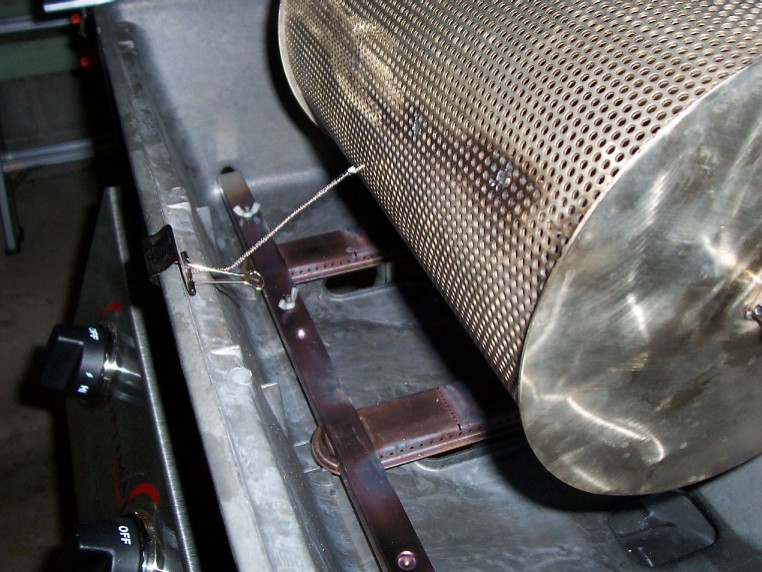

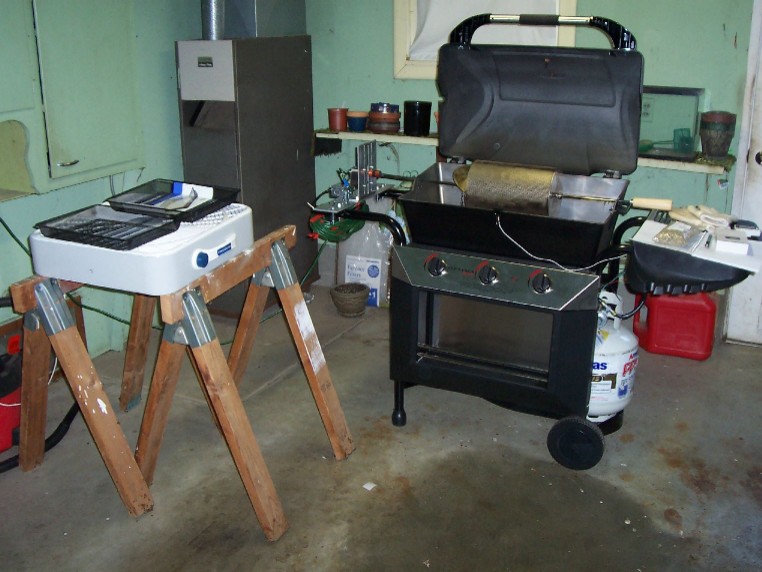
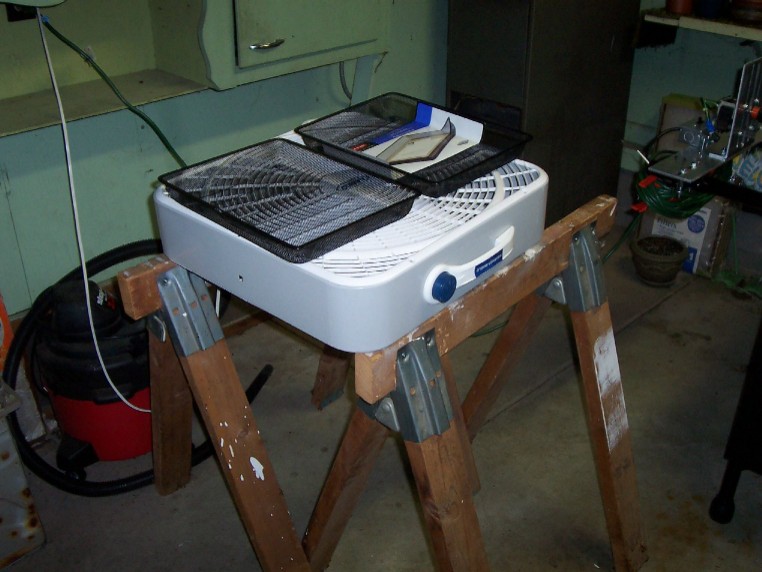


The Soup Can Roaster!
Stepless Doserless Rocky Modification